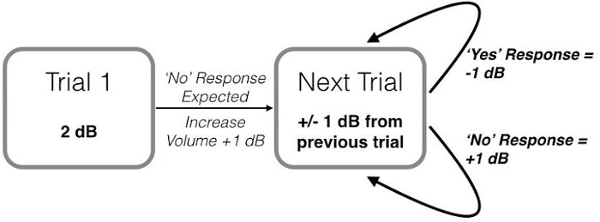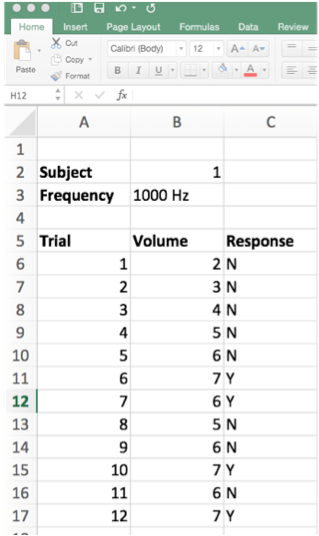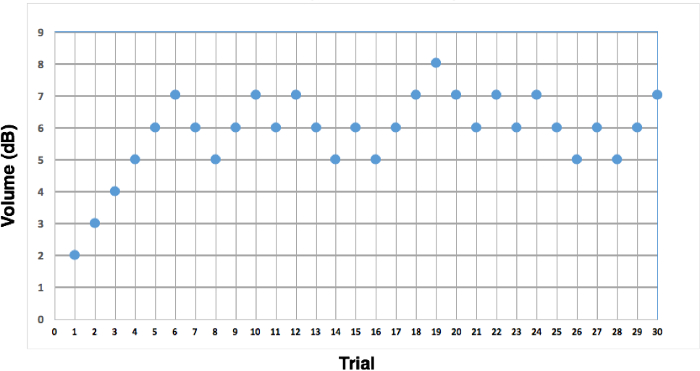知覚の限界を見つけるため階段のプロシージャ
概要
ソース: ジョナサン ・ Flombaum 講座-ジョンズ ・ ホプキンス大学
心理物理学は、知覚心理学の刺激の実際の強度をその知覚強度に関連するために設計されている一連のメソッドの名前です。心理物理学の 1 つの重要な側面を含む知覚閾値の測定: どのように明るい光がそれを検出することができる人のためする必要がありますが?どのように少し圧力が皮膚に適用、検出不可能ですか。音をどのソフトが、まだ聞いたことか。別の言い方をすれば、人間が感じることができる刺激の最小量は?階段手順は人の知覚的しきい値を識別するための効率的な方法です。
このビデオでは、人の聴覚閾値、音が知覚されるために必要な最小限のボリュームを識別するために階段のプロシージャを適用する標準的な方法を示します。
手順
1 刺激および装置
- この実験は、ヘッドフォンと比較的静かな実験室 (防音は必要ではありません) のセットと同様、基本的な実験的ソフトウェアを搭載したコンピューターが必要です。
- 実験では刺激は 1 kHz、2 kHz、3 kHz、4 kHz、5 kHz と 6 kHz の周波数の音になります。人間の聴覚は、この周波数範囲内で最適です。
- 実験の過程で、トーンのボリュームの変化となる適応 1 に 40 dB の範囲で各六つの周波数で最小限の知覚ボリュームを測定するために、実験的なデザインのコンテキストで明確になります。
2. デザイン
- 実験 6 周波数のそれぞれの六つのブロックが含まれます。これ人間のしきい値はすべての頻度のための同じではないためにです。つまり、閾値測定されますない個別ごとに六つの周波数。次のデザインはこのように六つのテスト プログラムを生成します。
- それぞれ試用期間中に特定の周波数を表示するテストをプログラムします。
- それぞれの試
結果
申請書と概要
参考文献
- Drake-Lee, A. B. (1992). Beyond music: auditory temporary threshold shift in rock musicians after a heavy metal concert. Journal of the royal society of medicine, 85(10), 617-619.
スキップ先...
このコレクションのビデオ:

Now Playing
知覚の限界を見つけるため階段のプロシージャ
Sensation and Perception
24.3K 閲覧数

色の残像
Sensation and Perception
11.1K 閲覧数

あなたの盲点と知覚充填で検索
Sensation and Perception
17.3K 閲覧数

感覚と知覚の視点
Sensation and Perception
11.8K 閲覧数

運動誘発性の失明
Sensation and Perception
6.9K 閲覧数

ゴム手の幻想
Sensation and Perception
18.4K 閲覧数

エイムズの部屋
Sensation and Perception
17.4K 閲覧数

非注意性盲目
Sensation and Perception
13.2K 閲覧数

空間手がかり
Sensation and Perception
14.9K 閲覧数

注意の瞬き
Sensation and Perception
15.9K 閲覧数

混雑
Sensation and Perception
5.7K 閲覧数

倒立顔の効果
Sensation and Perception
15.5K 閲覧数

マガーク効果
Sensation and Perception
16.0K 閲覧数

ちょうど顕著な違い
Sensation and Perception
15.3K 閲覧数

オブジェクト置き換えマスキング
Sensation and Perception
6.5K 閲覧数
Copyright © 2023 MyJoVE Corporation. All rights reserved


